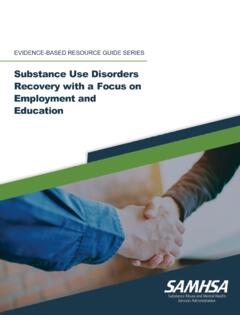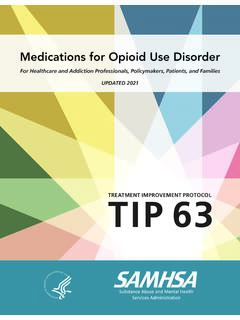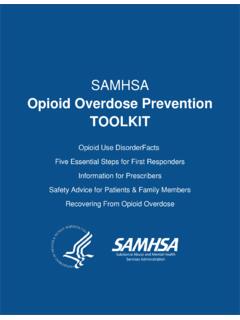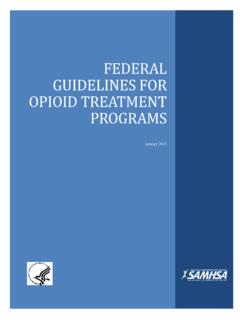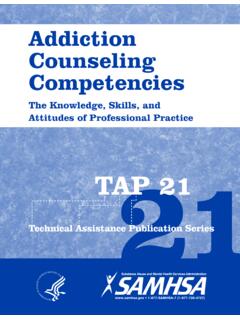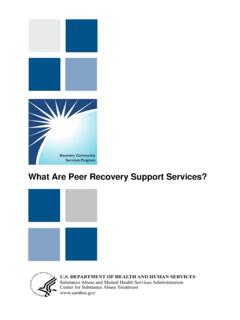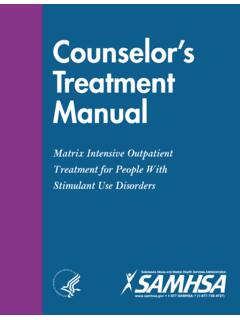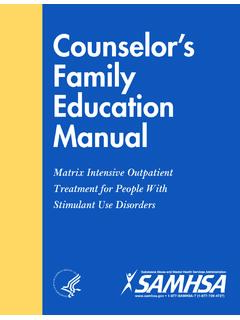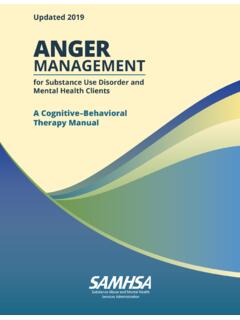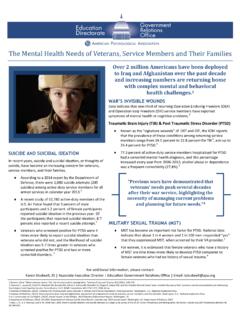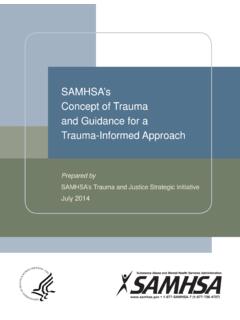Transcription of Projections of National Expenditures for Treatment of ...
1 Projections of National Expenditures for Treatment of Mental and Substance Use Disorders, 2010-2020. Projections of National Expenditures for Treatment of Mental and Substance Use Disorders, 2010 2020. Department of health and Human Services Substance Abuse and Mental health Services Administration ACKNOWLEDGMENTS. This report was prepared for the Substance Abuse and Mental health Services Administration (SAMHSA) by Truven health Analytics Inc. under SAMHSA IDIQ Prime Contract #HHSS283200700029I, Task Order #HHSS28342002T with SAMHSA, Department of health and Human Services (HHS). Jeffery Hunter served as the Contracting Officer Representative. DISCLAIMER. The views, opinions, and content of this publication are those of the authors and do not necessarily reflect the views, opinions, or policies of SAMHSA or HHS. PUBLIC DOMAIN NOTICE. All material appearing in this report is in the public domain and may be reproduced or copied without permission from SAMHSA.
2 Citation of the source is appreciated. However, this publication may not be reproduced or distributed for a fee without the specific, written authorization of the Office of Communications, SAMHSA, HHS. ELECTRONIC access AND COPIES OF PUBLICATION. This publication may be downloaded at Or, call SAMHSA at 1-877- SAMHSA7 (1-877-726-4727) (English and Espa ol). RECOMMENDED CITATION. Substance Abuse and Mental health Services Administration. Projections of National Expenditures for Treatment of Mental and Substance Use Disorders, 2010 2020. HHS. Publication No. SMA-14-4883. Rockville, MD: Substance Abuse and Mental health Services Administration, 2014. ORIGINATING OFFICES. Substance Abuse and Mental health Services Administration, 1 Choke Cherry Road, Rockville, MD 20857. HHS Publication No. SMA-14-4883. Printed in 2014. Executive Summary The Substance Abuse and Mental health Services Administration (SAMHSA) Spending Estimates (SSE) initiative was created to provide policymakers with essential information about Treatment service Expenditures for mental and substance use disorders (M/SUDs), sources of financing, and spending trends over The SSEs have helped to document past disparities through their ability to compare spending and financing sources for M/SUD Treatment with those for all- health spending.
3 Such comparisons can be performed because the SSEs were designed to closely align with the National health Expenditure Accounts (NHEA), which are produced annually by the Centers for Medicare &. Medicaid Services (CMS). This report presents new analyses and Projections from 2010 through 2020. These forecasts are anchored in recent historical SSEs (Levit et al., 2013; SAMHSA, 2013). They incorporate recent legislative changes that impact coverage and eligibility expansions and include spending changes that are anticipated from the Affordable Care Act. Six policy questions are addressed in this report: How much money is projected to be spent in the United States for Treatment of M/SUDs during the targeted period? Who is expected to pay for mental health and substance use disorder Treatment , and how much will they spend? How much money is forecasted to be spent on services from various providers, such as hospitals, physicians, and specialty mental health and substance abuse centers?
4 What is the anticipated spending change over time among providers and payers? How are trends in MH and SUD Treatment Expenditures expected to compare with those for all health care spending? Spending for M/SUD Treatment services measured in these accounts are defined by diagnostic codes found in the International Classification of Diseases, Ninth Revision, Clinical Modification (ICD-9-CM). as mental disorders ( , codes in sections 290 through 319; see Appendix Table ). A subset of these mental disorders, including dementia, tobacco use disorders, developmental delays, and intellectual disabilities, is excluded as being outside the scope of this project. M/SUD spending Projections in this report focus on Expenditures for Treatment and not disease burden. They include only spending for the direct Treatment of M/SUDs and exclude other substantial comorbid health costs that can result from M/SUDs ( , trauma and liver cirrhosis). Other costs of patient care such as job training and subsidized housing are also excluded, as are indirect costs such as lost wages and productivity.
5 Major findings include: M/SUD Treatment spending from all public and private sources is expected to total $ billion in 2020, which is an increase from $ billion in 2009. These amounts include the effects of the Affordable Care Act. M/SUD Treatment spending growth is likely to slow from recent trends and lag behind growth in all- health spending. M/SUD Treatment spending is expected to average annual growth of 1. Throughout the report, we use the traditional labels of mental health (MH), substance use disorders (SUD), or combined mental and substance use disorders (M/SUD) for services, treatments, or spending. We also use these terms for individuals when we refer to their problems, illnesses, or disorders for all levels of severity (Institute of Medicine, 2006). SAMHSA Spending Projections , 2010 2020 iii Executive Summary percent from 2009 through 2020, compared with an all- health spending growth of percent each year. One major reason for the slower spending growth for M/SUD Treatment is expected to be the large number of prescription drugs used to treat M/SUDs that will lose patent protection through 2020.
6 Loss of patent protection will allow entry of generic drugs, with an anticipated rapid switch by consumers to these lower-cost medications. In addition, few if any new innovative drugs are expected to enter the market. Together, these factors are predicted to slow spending growth, most notably for mental health Treatment . Closure of state psychiatric hospital beds is also contributing to slower M/SUD spending growth. Nine state hospitals and nine percent of state hospital beds closed between 2009 and 2012. Although the closure of state psychiatric hospitals is a long-run trend going back to the 1950s, closures accelerated in recent years as a result of state financing pressures stemming from the recession. As a result of slower growth in M/SUD Treatment spending compared with all- health spending, M/SUD Treatment spending as a share of all- health spending is expected to fall from percent in 2009 to percent in 2020. The implementation of the Affordable Care Act is expected to add percent, or $ billion, to the level of M/SUD spending in 2020, as an expected 25 million people who were previously uninsured gain health insurance coverage.
7 The Affordable Care Act and other recent legislation are predicted to increase all- health spending for Medicaid and private insurance and to slow the rate of increase in out-of-pocket and Medicare spending. Similar trends are expected for M/SUD spending. Even with increased spending for Medicaid because of the Affordable Care Act, the share of Medicaid budgets spent on treating M/SUD is expected to decline. In 2009, percent of Medicaid spending went for MH Treatment ; by 2020, that share is expected to fall to percent. Similarly, Medicaid spent percent on Treatment SUDs in 2009 a share that is expected to be percent in 2020. All Projections , including those shown in this report, have some degree of uncertainty. Nevertheless, Projections are useful tools for envisioning future spending and understanding the drivers of potential changes in spending. SAMHSA Spending Projections , 2010 2020 iv Executive Summary Contents Executive Summary .. iii Contents.
8 V Introduction .. 1. Overview of Treatment Service Expenditures for Mental and Substance Use Disorders .. 9. Growth in M/SUD Treatment Spending Is Expected to Slow and Lag Behind All- health Spending Growth Through 10. The Mental health Share of All- health Spending Is Expected to Fall Through 2020, as a Result of Slowing Mental health Spending Growth .. 11. Affordable Care Act Coverage Expansion Is Expected to Increase M/SUD and All- health Medicaid and Private Insurance Spending, and Decrease M/SUD and All- health Out-of- Pocket and Medicare Spending .. 12. The Affordable Care Act Is Likely to Add Percent to M/SUD Treatment Spending in 2020.. 14. Substance Use Disorder Treatment Spending Is Likely to Increase Slightly as a Share of All M/SUD Treatment Spending Over the Next Decade .. 15. Mental health Treatment Expenditures , Total and by Payer, 2010 17. Growth in Mental health Treatment Spending Is Predicted to Slow as Drugs Introduced in the Late 1990s Lose Patent Protection.
9 18. Medicaid Is Expected to Finance a Large and Growing Share of Mental health Treatment Spending .. 19. Medicaid Expansion Under the Affordable Care Act Is Likely to Drive Mental health Treatment Spending Increases Through 2020 .. 20. Medicaid Mental health Treatment Spending Is Predicted to Be a Smaller Share of All Medicaid Spending in 2020 Than in 2009 .. 21. Expenditures for Mental health Treatment by Provider, 2010 2020 .. 23. Prescription Drug and Hospital Spending Is Expected to Be a Smaller Share of Mental health Treatment Spending in 2020 Than in 2009 .. 24. Lower Prescription Drug Prices Are Expected to Reduce the Contribution of Drug Spending to Mental health Treatment Spending Increases .. 25. Lingering Effects of the Recession Are Projected to Slow Growth in State-Owned Psychiatric Hospitals Through 2014 .. 26. Specialty Mental health Providers Are Expected to Remain the Main Recipients of Mental health Treatment Spending .. 27. Patent Expirations and a Dry Drug Pipeline Are Expected to Produce Slow Spending for Mental health Prescription Drugs.
10 28. Expenditures for Substance Use Disorder Treatment , Total and by Payer, 2010 2020 .. 29. SUD Treatment Spending Is Expected to Grow as Uninsured Adults Gain Insurance Coverage From the Affordable Care Act .. 30. SAMHSA Spending Projections , 2010 2020 v Contents Medicaid Is Projected to Become a Larger Share of SUD Treatment Spending as Medicaid Eligibility Expands .. 31. Medicaid and Other State and Local Payers Are Projected to Account for Largest Increases in SUD Treatment Spending .. 32. Medicaid SUD Treatment Spending Is Predicted to Be Only Percent of All Medicaid Spending in 2020 .. 33. Expenditures for Substance Use Disorder Treatment by Provider, 2010 35. Private Insurance and Medicaid Enrollment Expansion Is Projected to Drive an increasing Spending Share for Office-Based Professionals .. 36. Specialty Substance Abuse Centers and Hospitals Are Anticipated to be Largest Contributors to the Increase in SUD Treatment Spending .. 37. Buprenorphine-Naloxone Goes Off Patent in 2013, Driving Lower Spending on Medications to Treat 38.


